Why Photography is an Art?
Whoever has access to the machine or technology stands a higher chance of becoming an artist in the discipline that particular technology gives birth to. In the past, only a handful of people, mostly elites, could have their photographs taken. Even fewer could lay their hands on a camera and call themselves a ‘photographer’. Barring the handful of exceptions, it is said, the earliest photographer was in fact a technician and not really an artist. But as the photo technology advanced and cameras became more accessible it started emerging as an art form.
Fast forward to the current times. The smartphone camera has literally nudged the artist in so many of us. Directly appealed to it. Instead of artist going to the camera, we can say the camera has come to the artist first. Even I didn’t consider photography for my own artistic expression till the smartphone cameras became advanced enough to capture better photos.
In order to master any art form an artist is expected to sufficiently familiarise with the technicalities of the medium of choice. Though the ultimate goal of several artists is elevation of an art that is beyond the constraints of form and medium. But it happens gradually and over a period of time. Sometimes it can take centuries for a medium of art to truly mature and come of age.
Since the beginning, photography went through several shifts before it could be widely considered as art. Some believe that the revolution did not take place till the 1960s. After all, photography emerged with the advancements in science and chemicals. The early enthusiasts of the medium struggled with perfecting this unique technology. It was trying to emerge at a time when painting was thriving. Photography of course did not find much acceptance among the ardent lovers of art. As a medium its potential lied in producing near perfect close to reality images or scenes. But it was time consuming, bulky and was far from successful in producing those promising real images. On the other hand, paintings in addition to being colourful were making all sorts of headways. Though it was a cousin of paintings the end result was nowhere near as splendid as paintings. Despite these limitations, in the mid 1800s several western photographers such as Gustave Le Grey, Oscar Rejlander, Henry Peach Robinson, Felix Nadar and Lady Hawarden tried to project photography as an art. In a way they laid the foundation of art photography.
Since photographs also dealt with the visuals, just like paintings, photographers back then were naturally influenced by paintings. But interestingly as the technology advanced and camera became more accessible it was quickly seen as a threat to paintings. Now, paintings were getting influenced by photographs. In a way, both the mediums benefited from each other. Moreover, photography also witnessed the influence of similar Art Movements like paintings did.
If the purpose of great art is to shake things up and leave a profound impact than this photo of a man standing in front of a line of tankers managed to do both. This is one of the many famous photographs that sent ripples across the world as it symbolised resistance. It was clicked in 1989 by Jeff Widener. If we look at this picture from the lens of Art Movements then this can be an example of Straight Photography or Documentary Photography.

The evolution of camera and photography was a revolutionising force in the visual arts discipline. It is crucial for an artist to be able to see the world around him or her in ways that the rest of the people don’t. The camera lets the artist to not just freeze the moments but also re-interpret the world around him or her. And the viewer is free to interpret the end result as well.

Why The Black Bored? Why Art?
Now more than ever we need Art. Technologically these are the most craziest and dizzying times. The threat of all of us moving away from each other is real.

